Experimental Investigation on Interfacial Defect Criticality of FRP-Confined Concrete Columns
Abstract
:1. Introduction
2. Materials and Methods
2.1. FRP Confined Columns and Defects Arrangment
2.2. Test Instrumentation
3. Results
3.1. Stress–Strain Behavior
3.2. Failure Modes
4. Discussions
4.1. Ultimate Performance of FRP Confined Column with Defect
4.2. Stress–Strain Model of FRP Confined Column with Interfacial Defects
5. Conclusions
Author Contributions
Funding
Conflicts of Interest
References
- Qin, R.; Zhou, A.; Lau, D. Effect of reinforcement ratio on the flexural performance of hybrid FRP reinforced concrete beams. Compos. Part B Eng. 2017, 108, 200–209. [Google Scholar] [CrossRef]
- Zhou, A.; Tam, L.H.; Yu, Z.; Lau, D. Effect of moisture on the mechanical properties of CFRP-wood composite: An experimental and atomistic investigation. Compos. Part B Eng. 2015, 71, 63–73. [Google Scholar] [CrossRef]
- Lau, D.; Jian, W.; Yu, Z.; Hui, D. Nano-engineering of construction materials using melecular dynamics simulatioins: Prospects and challenges. Compos. Part B Eng. 2018, 143, 282–291. [Google Scholar] [CrossRef]
- Teng, J.G.; Yuan, H.; Chen, J.F. FRP-to-concrete interfaces between two adjacent cracks: Theoretical model for debonding failure. Int. J. Solids Struct. 2006, 43, 5750–5778. [Google Scholar] [CrossRef] [Green Version]
- Liu, T.; Song, W.; Zou, D.; Li, L. Dynamic mechanical analysis of cement mortar prepared with recycled cathode ray tube (CRT) glass as fine aggregate. J. Clean. Prod. 2018, 174, 1436–1443. [Google Scholar] [CrossRef]
- Wu, Y.F.; Jiang, C. Effect of load eccentricity on the stress-strain relationship of FRP-confined concrete columns. Compos. Struct. 2013, 98, 228–241. [Google Scholar] [CrossRef]
- Zhou, A.; Qin, R.; Feo, L.; Penna, R.; Lau, D. Investigation on interfacial defect criticality of FRP-bonded concrete beams. Compos. Part B Eng. 2017, 113, 80–90. [Google Scholar] [CrossRef]
- Zhou, A.; Chow, C.L.; Lau, D. Structural behavior of GFRP reinforced concrete columns under the influence of chloride at casting and service stages. Compos. Part B Eng. 2017, 136, 1–9. [Google Scholar] [CrossRef]
- Zhou, A.; Büyüköztürk, O.; Lau, D. Debonding of concrete-epoxy interface under the coupled effect of moisture and sustained load. Cem. Concr. Compos. 2017, 80, 287–297. [Google Scholar] [CrossRef]
- Wan, B.; Jiang, C.; Wu, Y.-F. Effect of defects in externally bonded FRP reinforced concrete. Constr. Build. Mater. 2018, 172, 63–76. [Google Scholar] [CrossRef]
- Yu, Z.; Zhou, A.; Lau, D. Mesoscopic packing of disk-like building blocks in calcium silicate hydrate. Sci. Rep. 2016, 6, 36967. [Google Scholar] [CrossRef] [PubMed] [Green Version]
- Yu, T.-Y.; Boyaci, B.; Wu, H.F. Simulated transient electromagnetic response for the inspection of GFRP-Wrapped concrete cylinders using radar NDE. Res. Nondestruct. Eval. 2013, 24, 125–153. [Google Scholar] [CrossRef]
- Qiu, Q.; Lau, D. A novel approach for near-surface defect detection in FRP-bonded concrete systems using laser reflection and acoustic-laser techniques. Constr. Build. Mater. 2017, 141, 553–564. [Google Scholar] [CrossRef]
- Hu, Y.-J.; Jiang, C.; Liu, W.; Yu, Q.-Q.; Zhou, Y.-L. Degradation of the in-plane shear modulus of structural BFRP laminates due to high temperature. Sensors 2018, 18, 3361. [Google Scholar] [CrossRef] [PubMed]
- Qiu, Q.; Qin, R.; Lam, J.H.M.; Tang, A.M.C.; Leung, M.W.K.; Lau, D. An innovative tomographic technique integrated with acoustic-laser approach for detecting defects in tree trunk. Comput. Electron. Agric. 2019, 156, 129–137. [Google Scholar] [CrossRef]
- Qin, R.; Qiu, Q.; Lam, J.H.M.; Tang, A.M.C.; Leung, M.W.K.; Lau, D. Health assessment of tree trunk by using acoustic-laser technique and sonic tomography. Wood Sci. Technol. 2018, 52, 1113–1132. [Google Scholar] [CrossRef]
- Yuan, F.; Chen, M. Numerical sensing of plastic hinge regions in concrete beams with hybrid (FRP and steel) bars. Sensors 2018, 18, 3255. [Google Scholar] [CrossRef]
- Liu, T.; Zou, D.; Du, C.; Wang, Y. Influence of axial loads on the health monitoring of concrete structures using embedded piezoelectric transducers. Struct. Heal. Monit. 2017, 16, 202–214. [Google Scholar] [CrossRef]
- Tam, L.-H.; Zhou, A.; Yu, Z.; Qiu, Q.; Lau, D. Understanding the effect of temperature on the interfacial behavior of CFRP-wood composite via molecular dynamics simulations. Compos. Part B Eng. 2017, 109, 227–237. [Google Scholar] [CrossRef]
- Jiang, C.; Wu, Y.F.; Dai, M.J. Degradation of steel-to-concrete bond due to corrosion. Constr. Build. Mater. 2018, 158, 1073–1080. [Google Scholar] [CrossRef]
- Yu, Q.Q.; Gao, R.X.; Gu, X.L.; Zhao, X.L.; Chen, T. Bond behavior of CFRP-steel double-lap joints exposed to marine atmosphere and fatigue loading. Eng. Struct. 2018, 175, 76–85. [Google Scholar] [CrossRef]
- Qin, R.; Hao, H.; Rousakis, T.; Lau, D. Effect of shrinkage reducing admixture on the new-to-old concrete interface. Compos. Part B Eng. 2019, 167, 346–355. [Google Scholar] [CrossRef]
- Li, P.; Sui, L.; Xing, F.; Huang, X.; Zhou, Y.; Yun, Y. Effects of aggregate types on the stress-strain behavior of fiber reinforced polymer (FRP)-confined lightweight concrete. Sensors 2018, 18, 3525. [Google Scholar] [CrossRef] [PubMed]
- Yu, Q.-Q.; Wu, Y.-F. Fatigue retrofitting of cracked steel beams with CFRP laminates. Compos. Struct. 2018, 192, 232–244. [Google Scholar] [CrossRef]
- Xu, Y.; Liu, C.; Chai, L.; Lu, M.; Luo, C. Failure mechanism of fiber-reinforced polymer-confined concrete column with initial defects. J. Compos. Mater. 2018, 52, 2887–2897. [Google Scholar] [CrossRef]
- Achillopoulou, D.V. Investigation of the load transfer along interfaces of jacketed square columns. Struct. Eng. Mech. 2017, 63, 293–302. [Google Scholar]
- Achillopoulou, D.V.; Kiziridou, A.N.; Papachatzakis, G.A.; Karabinis, A.I. Investigation of interface response of reinforced concrete columns retrofitted with composites. Steel Compos. Struct. 2016, 22, 1337–1358. [Google Scholar] [CrossRef]
- Yu, T.; Cheng, T.K.; Zhou, A.; Lau, D. Remote defect detection of FRP-bonded concrete system using acoustic-laser and imaging radar techniques. Constr. Build. Mater. 2016, 109, 146–155. [Google Scholar] [CrossRef]
- Lau, D.; Qiu, Q.; Zhou, A.; Chow, C.L. Long term performance and fire safety aspect of FRP composites used in building structures. Constr. Build. Mater. 2016, 126, 573–585. [Google Scholar] [CrossRef]
- Zhou, Y.; Guo, M.; Sui, L.; Xing, F.; Hu, B.; Huang, Z.; Yun, Y. Shear strength components of adjustable hybrid bonded CFRP shear-strengthened RC beams. Compos. Part B Eng. 2019, 163, 36–51. [Google Scholar] [CrossRef]
- Ozbakkaloglu, T. Compressive behavior of concrete-filled FRP tube columns: Assessment of critical column parameters. Eng. Struct. 2013, 51, 188–199. [Google Scholar] [CrossRef] [Green Version]
- Zeng, J.J.; Guo, Y.C.; Gao, W.Y.; Chen, W.P.; Li, L.J. Stress-strain behavior of concrete in circular concrete columns partially wrapped with FRP strips. Compos. Struct. 2018, 200, 810–828. [Google Scholar] [CrossRef]
- Achillopoulou, D.V.; Rousakis, T.C.; Karabinis, A.I. Square reinforced concrete columns with slender bars strengthened through Fiber reinforced polymer (FRP) sheet straps. In Proceedings of the 6th Conference on FPR, Composites in Civil Engineering—CICE 2012, Rome, Italy, 13–15 June 2012. [Google Scholar]
- Mohamed, H.M.; Masmoudi, R. Axial Load capacity of concrete-filled FRP tube columns: Experimental versus theoretical predictions. J. Compos. Constr. 2010, 14, 231–243. [Google Scholar] [CrossRef]
- Lam, L.; Teng, J.G. Design-oriented stress-strain model for FRP-confined concrete. Constr. Build. Mater. 2003, 17, 471–489. [Google Scholar] [CrossRef]
- Teng, J.G.; Huang, Y.L.; Lam, L.; Ye, L.P. Theoretical Model for Fiber-reinforced polymer-confined concrete. J. Compos. Constr. 2007, 11, 201–210. [Google Scholar] [CrossRef]
- Karabinis, A.I.; Rousakis, T.C. Concrete confined by FRP material: A plasticity approach. Eng. Struct. 2002, 24, 923–932. [Google Scholar] [CrossRef]
- Richart, F.E.; Brandtzaeg, A.; Brown, R.L. A Study of the Failure of Concrete Under Combined Compressive Stresses. 1928. Available online: https://core.ac.uk/download/pdf/4814670.pdf (accessed on 23 January 2019).
- Du Béton, F.I. Externally bonded FRP reinforcement for RC structures. Bulletin 2001, 14, 138. [Google Scholar]
- Lam, L.; Teng, J.G. Ultimate condition of fiber reinforced polymer-confined concrete. J. Compos. Constr. 2004, 8, 539–548. [Google Scholar] [CrossRef]
- Rousakis, T.C.; Rakitzis, T.D.; Karabinis, A.I. Design-oriented strength model for frp-confined concrete members. J. Compos. Constr. 2012, 16, 615–625. [Google Scholar] [CrossRef]
- Lam, L.; Teng, J.G.; Cheung, C.H.; Xiao, Y. FRP-confined concrete under axial cyclic compression. Cem. Concr. Compos. 2006, 28, 949–958. [Google Scholar] [CrossRef]
- Jiang, T.; Teng, J.G. Analysis-oriented stress-strain models for FRP-confined concrete. Eng. Struct. 2007, 29, 2968–2986. [Google Scholar] [CrossRef]
- Kakaletsis, D.J.; David, K.N.; Karayannis, C.G. Effectiveness of some conventional seismic retrofitting techniques for bare and infilled R/C frames. Struct. Eng. Mech. 2011, 39, 499–520. [Google Scholar] [CrossRef]

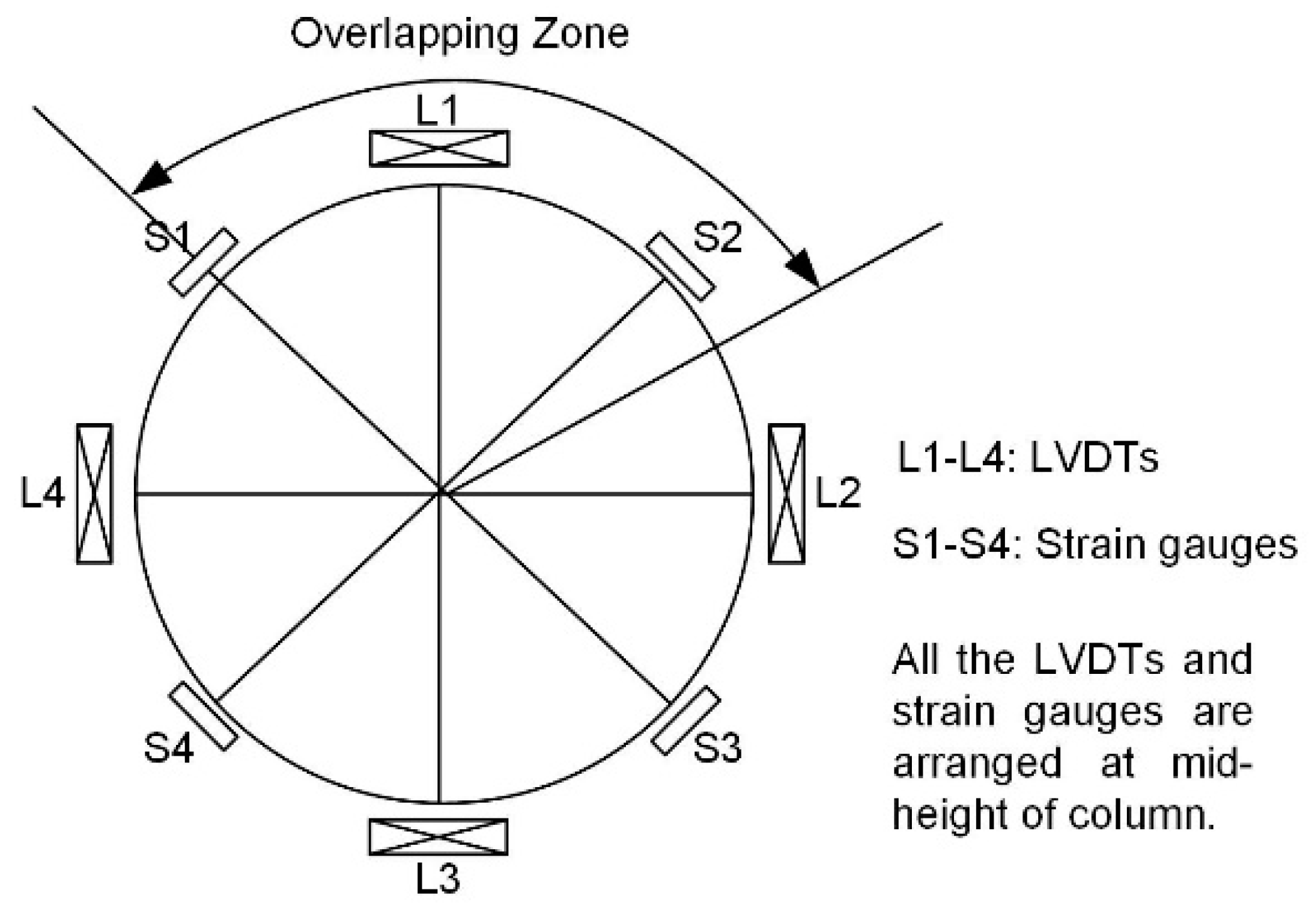
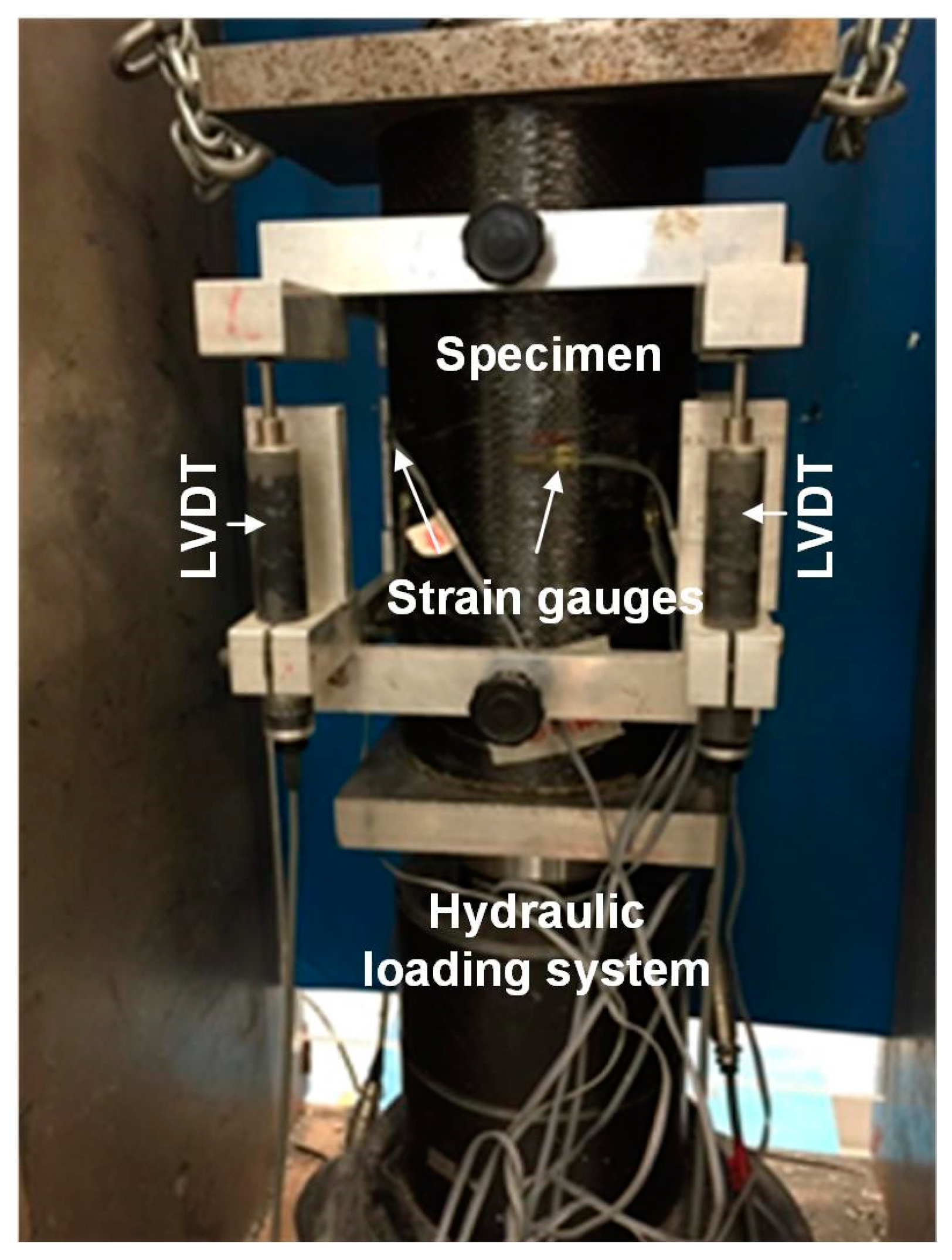
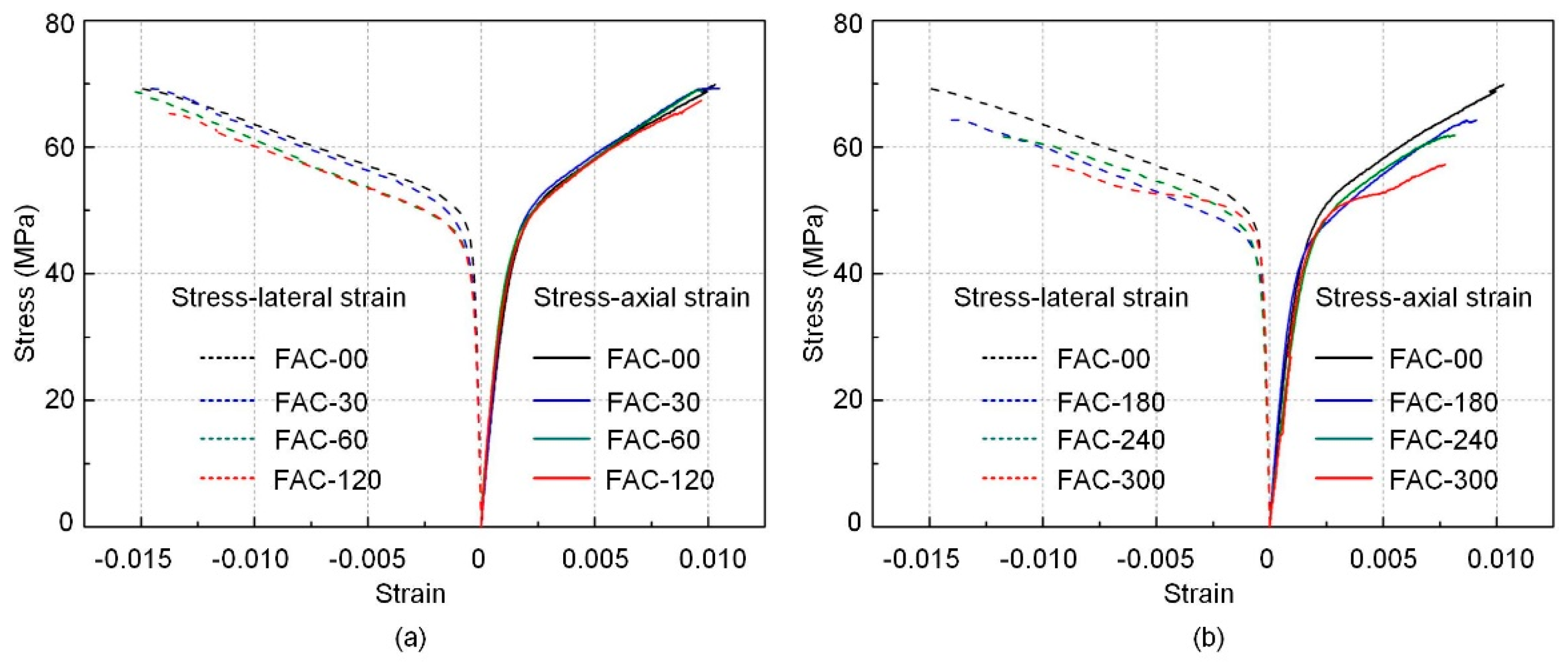
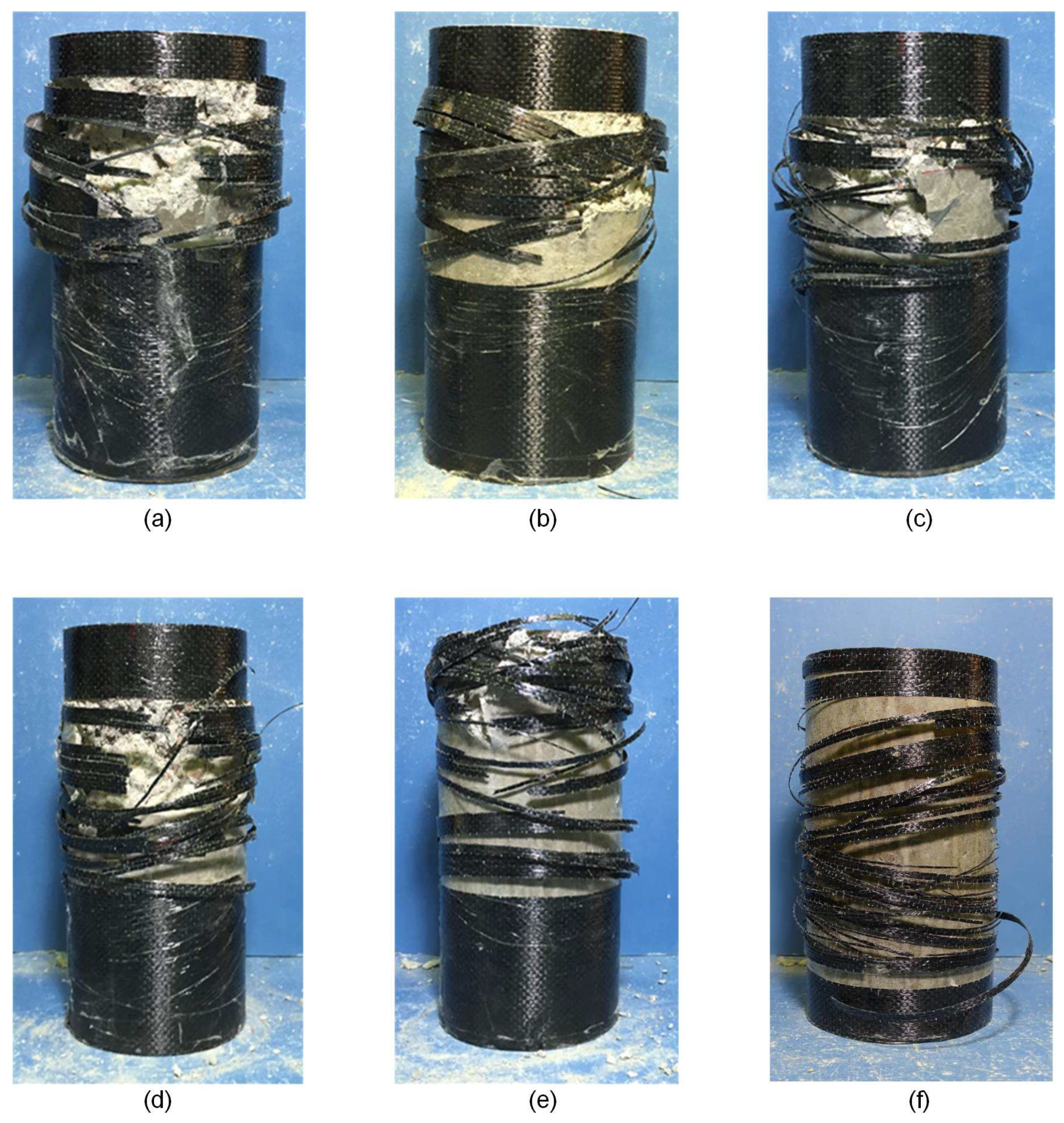

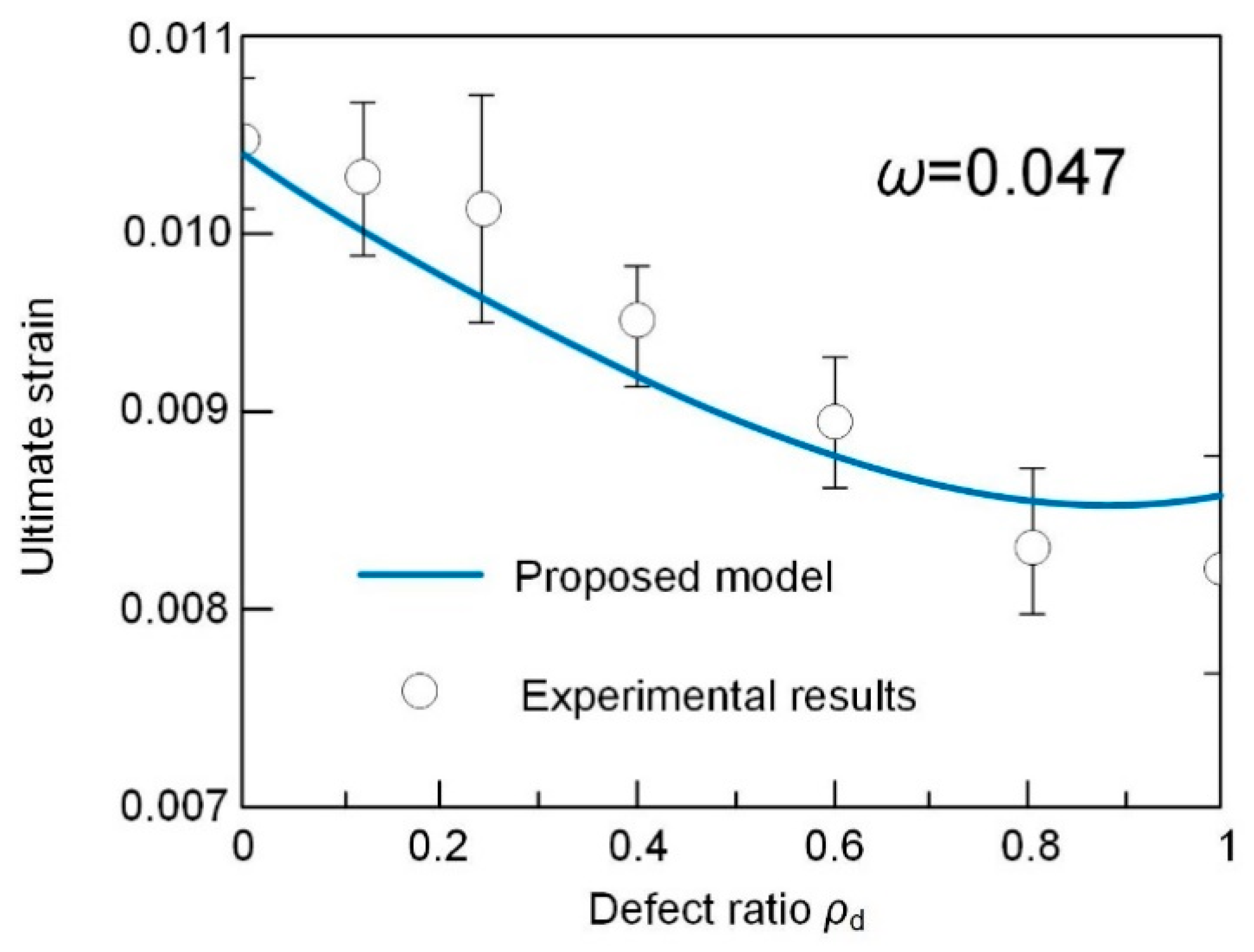


| Cement (kg/m3) | Sand (kg/m3) | Aggregate (kg/m3) | Water/Cement Ratio | Density (kg/m3) |
|---|---|---|---|---|
| 383 | 792 | 968 | 0.6 | 2374 |
| Specimen Name | No. of Samples | Defect Height | Percentage to Height |
|---|---|---|---|
| FAC-plain | 2 | Unstrengthened | -- |
| FAC-00 | 2 | Strengthened | -- |
| FAC-30 | 2 | 30 mm | 10% |
| FAC-60 | 2 | 60 mm | 20% |
| FAC-120 | 2 | 120 mm | 40% |
| FAC-180 | 2 | 180 mm | 60% |
| FAC-240 | 2 | 240 mm | 80% |
| FAC-300 | 2 | 300 mm | 100% |
| Specimen | Defect Height to Column Height | Ultimate Strength (MPa) | Ultimate Axial Strain | Ultimate Lateral Strain | fcu/fco | εcu/εco | Energy Absorption (MJ/m3) |
|---|---|---|---|---|---|---|---|
| FAC-Plain | - | 42.32 | 0.0021 | - | - | - | |
| FAC-00 | - | 69.87 | 0.0105 | 0.0157 | 1.65 | 5.00 | 0.585 |
| FAC-30 | 10% | 69.22 | 0.0103 | 0.0156 | 1.64 | 4.90 | 0.563 |
| FAC-60 | 20% | 69.28 | 0.0102 | 0.0153 | 1.64 | 4.90 | 0.532 |
| FAC-120 | 40% | 67.71 | 0.0097 | 0.0141 | 1.59 | 4.62 | 0.521 |
| FAC-180 | 60% | 64.27 | 0.0091 | 0.0131 | 1.52 | 4.33 | 0.466 |
| FAC-240 | 80% | 61.39 | 0.0082 | 0.0126 | 1.45 | 3.90 | 0.399 |
| FAC-300 | 100% | 58.36 | 0.0081 | 0.0102 | 1.38 | 3.85 | 0.358 |
© 2019 by the authors. Licensee MDPI, Basel, Switzerland. This article is an open access article distributed under the terms and conditions of the Creative Commons Attribution (CC BY) license (http://creativecommons.org/licenses/by/4.0/).
Share and Cite
Qin, R.; Lau, D.; Tam, L.-h.; Liu, T.; Zou, D.; Zhou, A. Experimental Investigation on Interfacial Defect Criticality of FRP-Confined Concrete Columns. Sensors 2019, 19, 468. https://doi.org/10.3390/s19030468
Qin R, Lau D, Tam L-h, Liu T, Zou D, Zhou A. Experimental Investigation on Interfacial Defect Criticality of FRP-Confined Concrete Columns. Sensors. 2019; 19(3):468. https://doi.org/10.3390/s19030468
Chicago/Turabian StyleQin, Renyuan, Denvid Lau, Lik-ho Tam, Tiejun Liu, Dujian Zou, and Ao Zhou. 2019. "Experimental Investigation on Interfacial Defect Criticality of FRP-Confined Concrete Columns" Sensors 19, no. 3: 468. https://doi.org/10.3390/s19030468





